How hard do you find the famous 60m FTP test? Have you ever tried it? Popular opinion is it is horribly difficult. So much so most people are scared to try. Yet I have seen 5000 people do a one hour competitive event ride eg Alpe D’Zwift race at one time! Consider the hour record, just 60mins long, but Merckx said it was “the hardest ride I have ever done”. So my question is:
Do you know the difference between fatigue and exhaustion?
Have you ever found your own limits to exhaustion?
What are the situations where you ride harder than you thought possible?
Today, I will explore the limits of fatigue, and in particular learn how to push yourself further than possible. Maybe the closest I got to exhaustion was 100km/3hrs indoors…..not very impressive until you realize this was 100% standing (not sitting down at all) (strava link). How many times have you been close to giving up, and then realized you can make it 5 mins more just to get to the finish line? The truth is, you can push yourself a lot further than you realize….as evidences by the number of athletes who push so hard, they literally crawl over the line.

What is Fatigue?
Everyone know what fatigue is, but we need to pin it down more precisely. Fatigue is defined:
as an inability to maintain a power output during repeated muscle contractions despite wanting to.
And it is important to know that there are two big components of fatigue: peripheral fatigue and central fatigue.
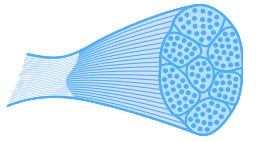
Peripheral fatigue is about the muscles’ ability to maintain desired force fueled by oxygen and glycogen and fatty acids. But peripheral fatigue contributes more in short duration, high intensity activity because it stems from a buildup of metabolic by products (not lactate! rapid turnover of ATP risks accumulation of protons at high exercise intensity but lactate production during intense exercise shuttles pyruvate to the liver and prevents pyruvate accumulation in the muscle and supplies the NAD(+) needed for phase 2 of glycolysis).
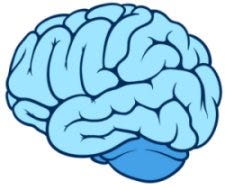
Central fatigue contributes more during lower intensity, endurance activity and has to do with high level monitoring from the brain. Central fatigue is somewhat mysterious as this fatigue occurs when the brain *intentionally* reduces neural drive to the muscles through a reduction in motor unit recruitment and in motor unit firing rate. Researchers think that a “central governor” mechanism in the central nervous system functions to protect the body from damage. Dr. Timothy Noakes says fatigue is more like an emotion or a sensation rather than an actual physical event that can be manipulated.
Central governor theory

Originally proposed by Archibald Hill then 70 years later by professor Tim Noakes, the thrust of the central governor theory is that the brain uses a mixture of conscious, sub-conscious and physiological cues to control the muscles and hold them back from reaching the true brink of exhaustion.
In other words, physiological factors (such as the level of muscle glycogen, lactate etc) are not the direct cause of fatigue, but just some of many signals that the brain takes into account along with other information, to set the level of fatigue you actually experience. According to the theory, the brain is constantly monitoring the situation and when it decides you’ve had enough, it creates the distressing sensations you then interpret as muscle fatigue.
Exercise intensity is regulated based on one’s perceived exertion in order to avoid the possibility of “catastrophic” or “critical” damage (ie severe disturbances to homeostasis). Basically your brain asks not just “can I continue right now?” but “is damage likely if I continue to the goal?” If there is not a reasonable chance of getting to the end goal + at the current pace + without harm, your brain will powerfully tell your muscles to slow down. This can be written in a perceived hazard score:
Chance of exhaustion (hazard score) = current perceived exertion x fatigue ramp rate x estimated time remaining x chance of organ damage

Take the example, of heart rate. Heart rate is regulated by the autonomic nervous system controlled by the brain. If during exercise, your heart rate goes dangerously high your brain will try and slow you down. But, more than this, if you heart rate is rising fast and your brain doesn’t think you can sustain that before the goal, your brain will try and slow you down as well!
I can simplify that here (figure) where tick = continue / cross = slow down
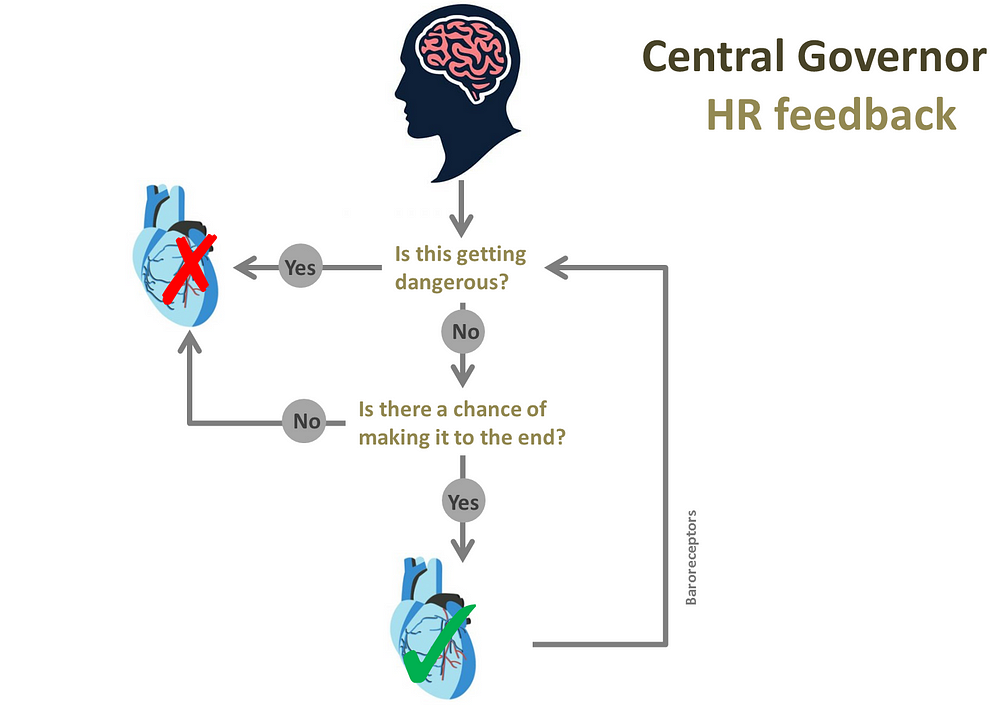
This is only one single branch of a complex safety mechanism that is integrated into the central governor. And all evidence says it is more than a theory, it is a major determinant of your performance.
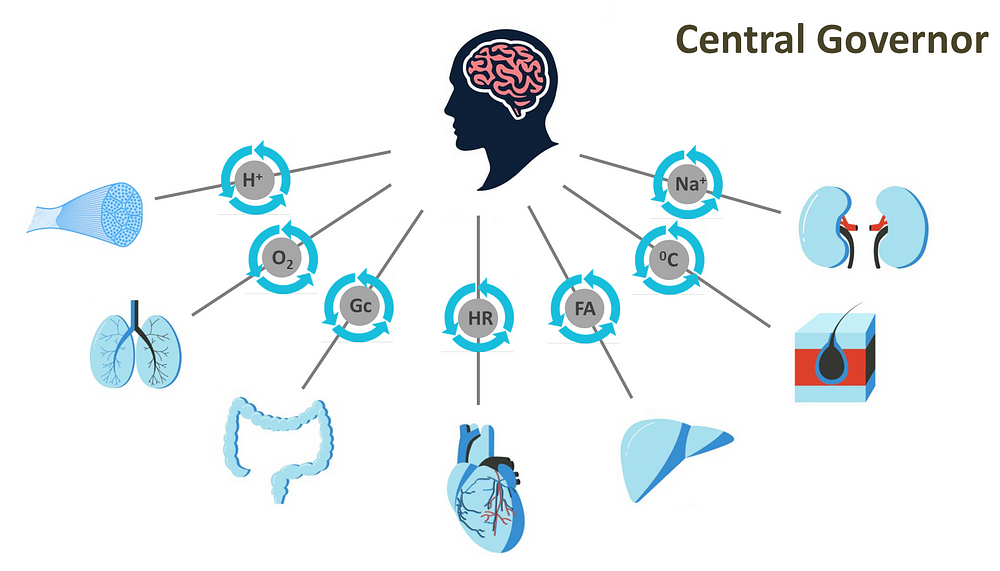
Now here is the interesting bit. The brain moderates your effort based on the *perceived conditions* such as the estimated time left in the event, or the likelihood of success…..so can the system be fooled into giving you a bit more? To answer this we have to look at feedback or deception studies.
Deception and Performance
As long ago as 1968 Boston Marathon champion Amby Burfoot described a “deception” workout where the coach makes you tackle an extra lap or extra repetition after you think you’re finished after pretending to miscount. “From this workout,” he wrote, “you’ll learn forever that you’re capable of much more than you think. It’s the most powerful lesson in running.”
Now fast forward to 2011 Kevin Thompson, head of sport and exercise science at Northumbrian University, did the same thing in an innovative study. He asked athletes to cycle against an on screen avatar which he told them was their PR/PB time. But he cheated! The avatar was programmed to go 1% faster (with 2% more power) than their recent their PR/PB time! The surprise was 8 of 9 athletes improved their times (link) which they could not do simply by offering them money to beat their time! This was replicated by Ansdell (2018) and I have drawn it out here (figure:
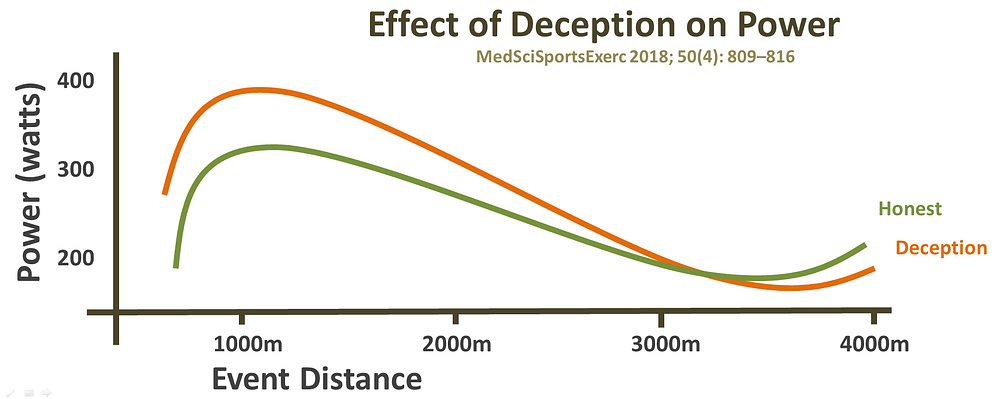
Notice the athletes who were cheated, did better right until close to the end, when I guess their additional effort caught up with them but by this time they were well ahead! Since then multiple studies have found the same result.
In their meta-analysis, Davies et al. explored the effects of environmental feedback interventions on pacing. In line with the above studies, 26 cycling studies demonstrated environmental effects of hypoxia, thermal aspects and feedback on pacing and performance.
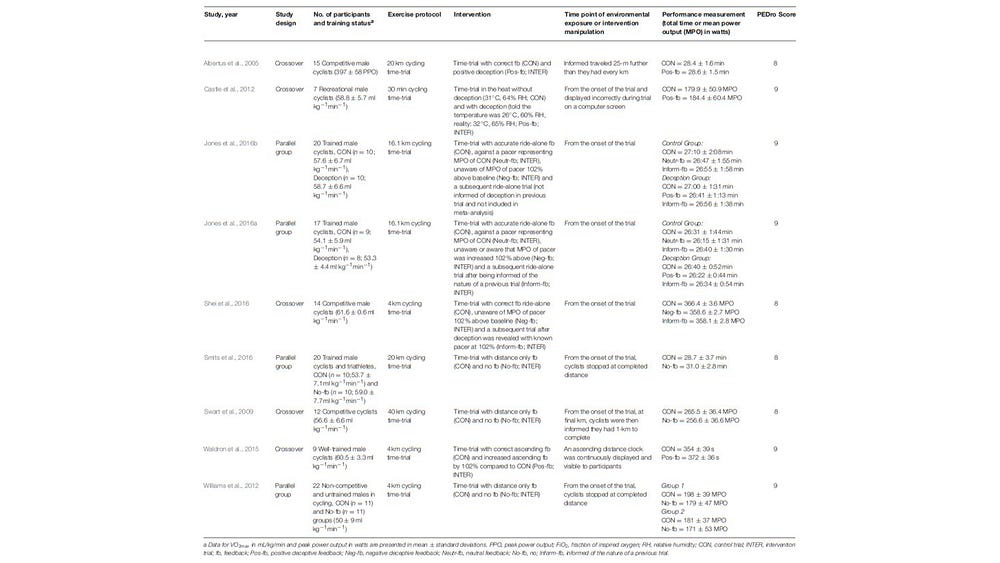
Feedback vs No Feedback (Blind)
However, there is a factor that these deception studies did not consider. Even if you have ridden a course before then receiving accurate information on distance, power, cadence can give you a boost around 3% in event time and may improve your power up to 10% due to a combination of good pacing and a+ve motivational effect, as shown in this study by Wingfield (2018) (link):
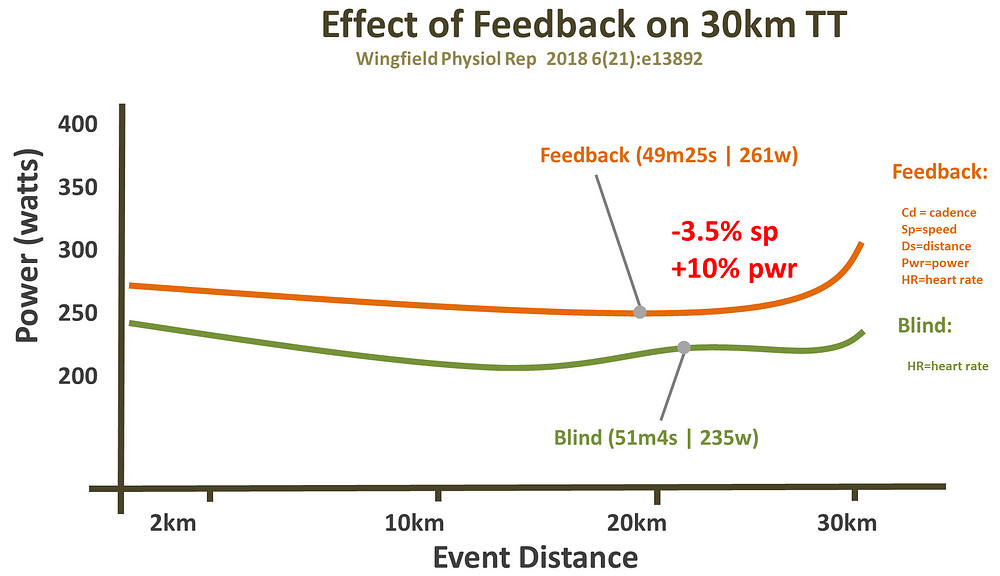
Indeed even the perceived effort/fatigue (RPE) you feel in a known race with feedback (at a faster pace) is about the same as in a race without feedback!
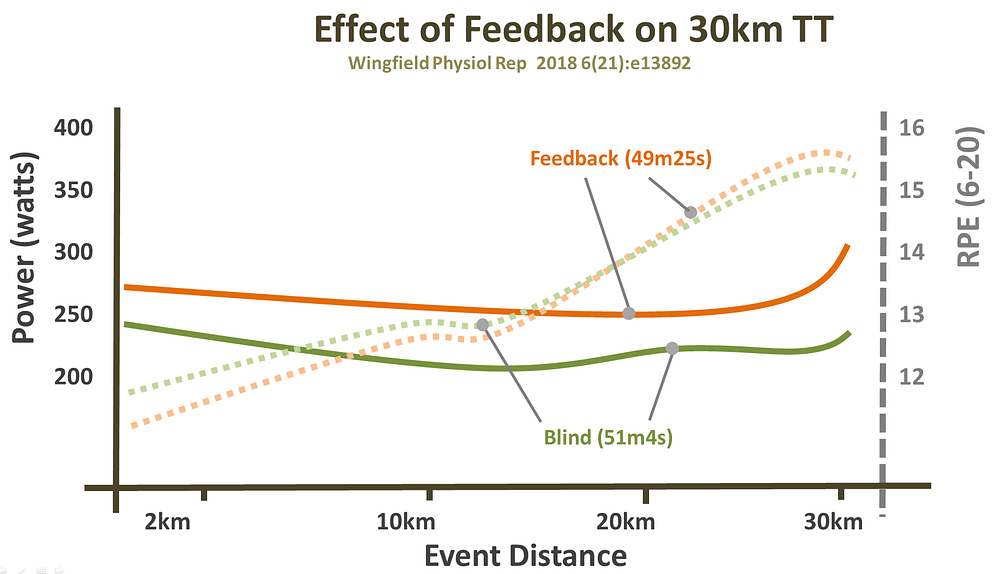
Competition vs no-Competition
A final factor to consider is the effect of racing someone else. Corbett (2012) studied 14 cyclists doing a 2000m TT. Power was sig higher when the athlete believed they were racing someone else (but they were only racing themselves) and times were improved by 2% (188.3seconds vs 184.6seconds). Only in the last 10% of the event did the solo performance “catch up” in terms of power output, almost exactly the same effect as above.
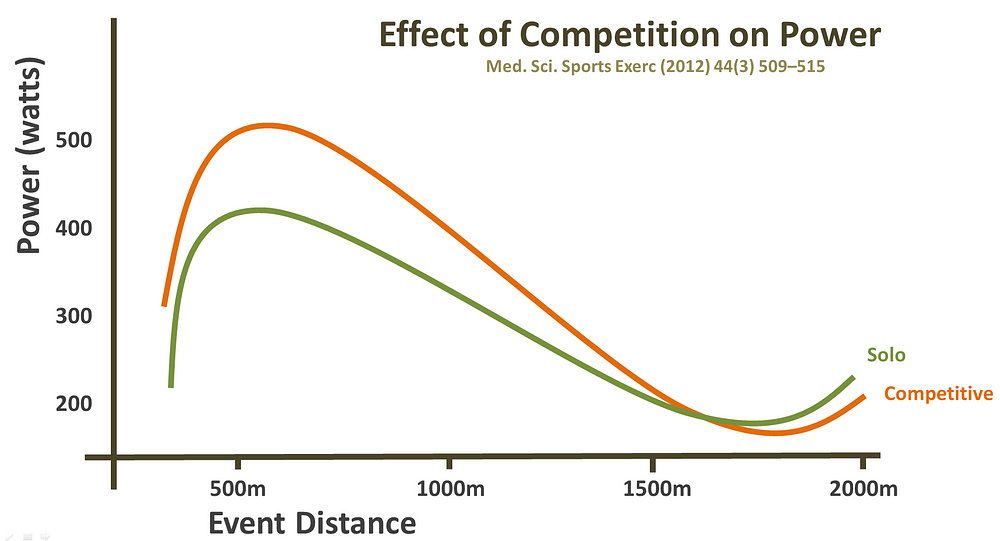
And so if we look at all the studies that have three conditions (plus a control….a rider “blind” with no feedback) we find this
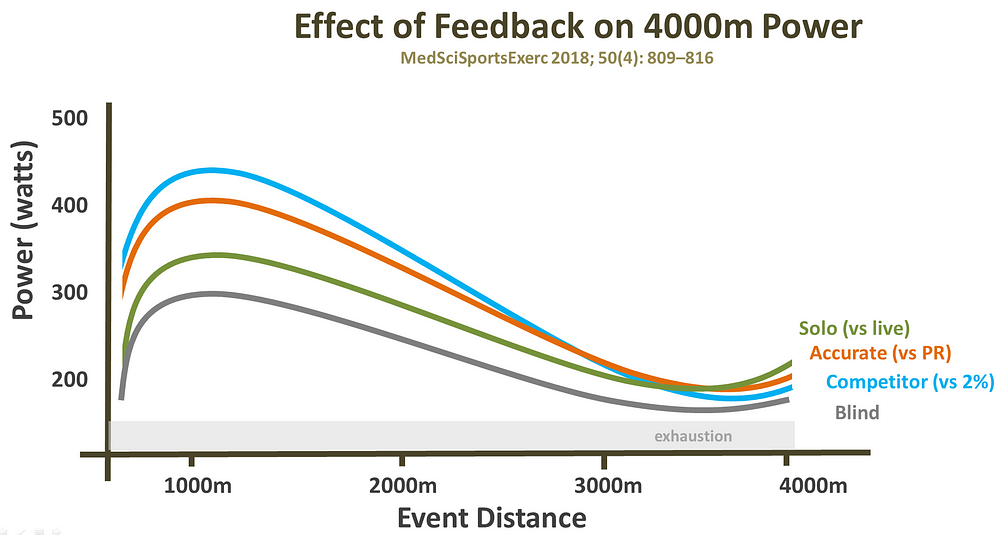
We can conclude that if you offer a carrot to an athlete in the form of their own PR avatar they will generally improve by about 1%, if you show them a mock competitor they will improve by another 1% (2% total)…..but there is a catch, if you show them a competitor 5% faster they may try and chase but will likely blow-up and stop, exhausted. It seems there is only so far that the central governor can be fooled!!
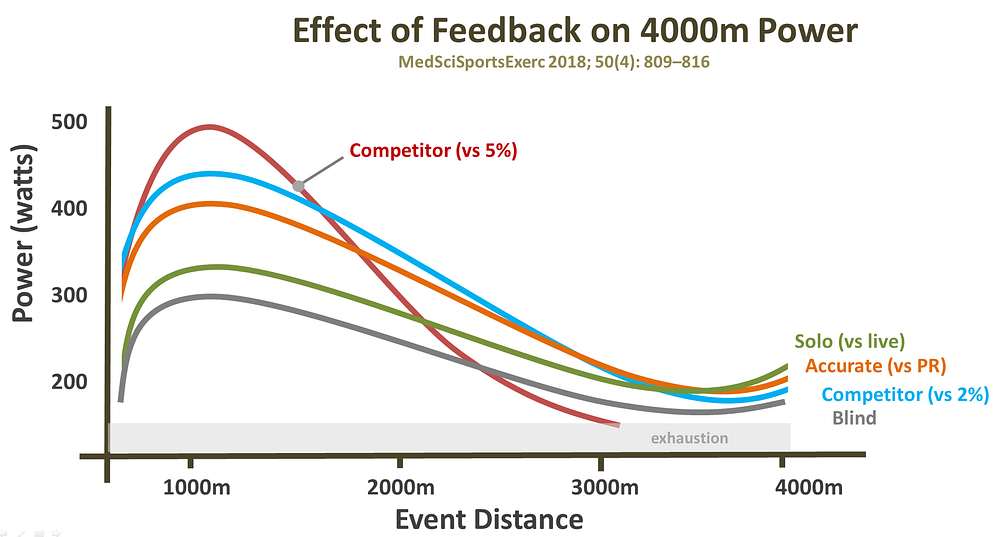
Recently, the mechanisms behind this have begun to be revealed.
Deception and the Brain
It has long been known (Merton 1954) that even in a fatigued state, muscle can produce surprising force if evoked by nerve stimulation during a maximal voluntary effort but the amplitude of the superimposed twitch decreases with increasing voluntary force. However it is also observed that stimulation of the motor cortex has also revealed submaximal activation of muscles during maximal voluntary efforts of respiratory muscles. What is new is that this could be functionally useful!
Brazilian researchers published a study showing that trained cyclists produced 4% more power and had lower heart rate and perceived effort during an incremental test after a 10-minute bout of tDCS (transcranial direct current stimulation, or tDCS). Read more here. What is going on? It turns out that perception of bodily fatigue(peripheral fatigue) might be located in the insular cortex and perception of effort (central fatigue) might be located in the anterior cingulate cortex. Two entirely separate areas.
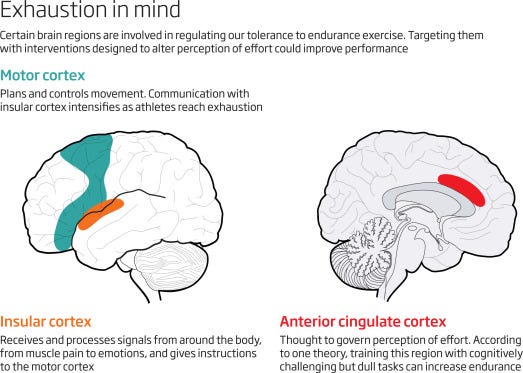

=================
Using central governor theory to your benefit
How can you apply central governor theory to enhance your own training? You might be using it already, but if not here is a list of 10 tips:
During sustained efforts, try and convince yourself you can go 1% faster, 2% harder (watts) and 5% further…..the truth is you can!
During interval efforts, at the end, try and tell yourself you can do one more, just one more and you can stop
During a hard threshold effort, when you are struggling, eg 20km in a 40km TT, tell yourself to get half-way to the end, so now you only have to get to 30km……then tell yourself to get half way again (35km) etc.
Use distraction. Music especially high BPM has a definite effect on power and endurance on most people
Try using positive affirmation (I am going to finish) or positive imagery techniques as these can reduce fatigue perception;
When riding solo, try to pace against your PR/PB eg at 5km then at 10km
Try and enter more events, even online (eg zwift…..yes that’s the zwift effect)…..in an event against real people you will often ride harder or faster or further than you expected.
In events (but also solo) imagine you are racing a rival, and that rival is closely matched with you….maybe the rider who happens to be in front (rival or not!)
When you can sense the finish line, push hard, even if you run out of steam you can usually get a big finish line advantage
When your muscles start to hurt, that’s your muscles way of asking your brain “hey, how long have a got”…..remember you can always reply “shut up legs!” “not much further” to quote a rather famous cyclist.

